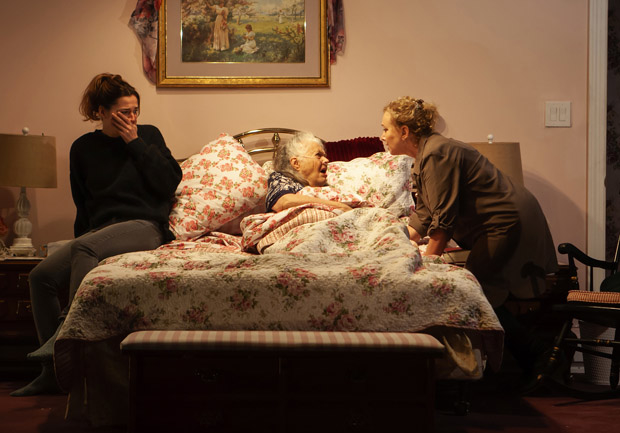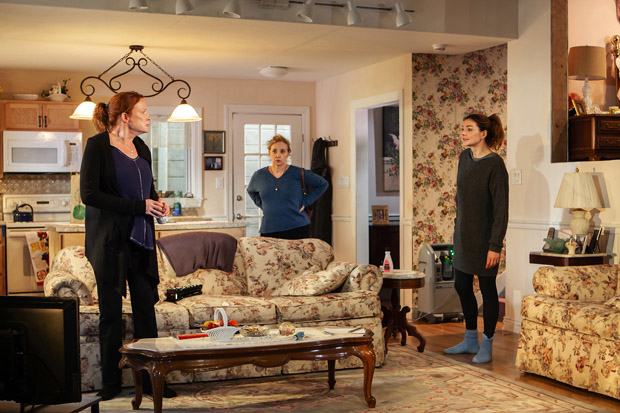There's No Peace in Peace for Mary Frances
Lois Smith stars as a dying matriarch in the professional debut of playwright Lily Thorne.

(© Monique Carboni)
Anyone who has watched an elderly relative slowly die will relate to Peace for Mary Frances, the playwriting debut of Lily Thorne. Thorne has likely taken a cue from the "write what you know" rulebook for this New Group premiere at the Pershing Square Signature Center. Unfortunately, the play, directed by Lila Neugebauer, circles the drain longer than the title character does.
Mary Frances (Lois Smith) has end-stage chronic obstructive pulmonary disease, and she is determined to die on her own terms. She's in home hospice care being watched over by her feuding daughters Alice (J. Smith-Cameron) and Fanny (Johanna Day). Fanny, a recovering heroin addict who resides in a sober-living community at the local Y, has a mood disorder. Alice, an astrologer with less than $100 to her name, spends money like she prints it herself. A son, Eddie, played by Paul Lazar, is less interested in family squabbles. As Mary Frances's warring children battle for control of their mother's final weeks, Mary Frances herself just wants enough peace to cut the cord.
Thorne is operating in epic, August: Osage County mode. Peace for Mary Frances navigates a head-spinning number of subjects, ranging from end-of-life care to inheritance to the Armenian genocide, with an equally unwieldy number of characters. Alice's grown daughters have their own issues: Rosie (Natalie Gold) has a newborn; Helen (Heather Burns), a TV star, has OCD and anger-management problems. A hospice care worker (Mia Katigbak), a social worker (Brian Miskell), and a home healthcare aide (Melle Powers) complete the vast ensemble.
But you can only get to know so much about people in a two-and-a-half hour play, and the motivations of many characters are wildly shortchanged. Gold is very good as the ostensible voice of reason, while Burns has an impressive, couch-flipping mad scene that goes nowhere. Lazar, meanwhile, does nothing but nonchalantly eat sushi by his dying mother's bedside. The secondary characters probably had more to do in a longer, earlier draft.
Similarly, Peace for Mary Frances never stops feeling like a hastily edited version of a longer play. Thorne spends too much time spinning her wheels; there's only so much for Alice, Fanny, and Mary Frances to fight about, so they just argue about the same things (mostly money) over and over. It's realistic, sure, but it doesn't make for very interesting theater. Neugebauer's usually invisible directorial hand is strangely heavy here as characters come and go from Dane Laffrey's believable split-level set, with movement and action seemingly compensating for the lack of exciting theatrics.
Sparks do fly in the three central performances. Both Smith-Cameron and Day are extremely believable in their desperation and exasperation, and the ever-indomitable Smith does some mighty-fine acting while confined to a bed. While none of them are at their peak, they are enjoyable to watch nonetheless.
Ultimately, Peace for Mary Frances is a relatable experience for those who've dealt with death firsthand. Thorne's first-produced play holds a clear mirror up to reality. It just forgot that its medium is theater.

(© Monique Carboni)







